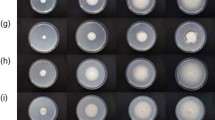Abstract
Freeze-fracturing of outer wall layers ofCladosporium conidia revealed two types of ultrastructure, coinciding with taxonomic characteristics. The outer conidial layers were essentially smooth in the human pathogenic species,C. bantianum, C. carrionii, andC. trichoides. In contrast, mosaic arrays of rodlets on conidia were observed with freeze-fracturing in the saprobic species,C. cladosporioides, C. coralloides, C. herbarum, C. sphaerospermum, andC. variabile. Conidia ofC. elatum were an exception among the saprobic species as they had smooth surfaces. The present study supports the suggestion that the human pathogenicCladosporium species should be transferred to another genus.
Similar content being viewed by others
References
Arx JA von (1983)Mycosphaerella and its anamorphs. Proc. K. Akad. Wet., Ser. C. 86: 15–54
Beever RE & Dempsey GP (1978) Function of rodlets on the surface of fungal spores. Nature 272: 608–610
Bowman BH & Taylor JW (1993) Molecular phylogeny of pathogenic and non-pathogenic Onygenales. In: Reynolds DR & Taylor JW (Eds) The Fungal Holomorph. (pp 169–178)
Brain APR & Young TWK (1979) Ultrastructure of the asexual apparatus inMycotypha (Mucorales). Microbios 25: 93–106
Branton D (1971) Freeze-etching studies of membrane structure. Philos. Trans. R. Soc. Lond. Biol. Sci. 261: 133–138
Bronchart R & Demoulin V (1971) Ultrastructure de la paroi des basidiospores deLycoperdon et deScleroderma (Gasteromycetes) comparée à celle de quelques autres spores de champignons. Protoplasma 72: 179–189
Figueras MJ, Guarro J & Dijk F (1988) Rodlet structure on the surface ofChaetomium spores. Microbios 53: 101–107
Hallett IC & Beever RE (1981) Rodlets on the surface ofNeurospora conidia. Trans. Br. Mycol. Soc. 77: 662–665
Hasegawa T (1975)Trichophyton rubrum andT. mentagrophytes studied by freeze-etching. Sabouraudia 13: 241–243
Hashimoto T, Wu-Yuan CD & Blumenthal HJ (1976) Isolation and characterization of the rodlet layer ofTrichophyton mentagrophytes microconidial wall. J. Bacteriol. 127: 1543–1549
Hawker LE & Madelin MF (1976) The dormant spore. In: Weber DJ & Hess WM (Eds) The Fungal Spore. (pp 1–72) Wiley & Sons, New York
Hess WM, Sassen MMA & Remsen CC (1968) Surface characteristics ofPenicillium conidia. Mycologia 60: 290–303
Hess WM & Stocks DL (1969) Surface characteristics ofAspergillus conidia. Mycologia 61: 560–571
Hess WM & Weber DJ (1973) Ultrastructure of dormant and germinated sporangiospores ofRhizopus arrhizus. Protoplasma 77: 15–33
Kwon-Chung KJ & Vries GA de (1983) Comparative study of an isolate resembling Banti's fungus withCladosporium trichoides. Sabouraudia 21: 59–72
Kwon-Chung KJ, Wickes BL & Plaskowitz J (1989) Taxonomic clarification ofCladosporium trichoides Emmons and its subsequent synonyms. J. Med. Vet. Mycol. 27: 413–426
Latgé JP, Bouziana H & Diaquin M (1988) Ultrastructure and composition of the conidial wall ofCladosporium cladosporioides. Can. J. Microbiol. 34: 1325–1329
Liu TP, Peng CYS, Mussen EC, Marston JM & Munn RJ (1991) Ultrastructure of the freeze-etched spore ofAscosphaera apis, an entomopathogenic fungus of the honeybeeApis mellifera. J. Inverteb. Path. 57: 371–379
Masclaux F, Guého E, Hoog GS de & Christen R (1995) Phylogenetic relationships of human-pathogenicCladosporium (Xylophypha) species inferred from partial LS rRNA sequences. J. Med. Vet. Mycol. (in press)
Tewari JP, Skoropad WP & Malhotra SK (1980) Multilamellar surface layer of the cell wall ofAlbugo candida andPhycomyces blakesleeanus. J. Bacteriol. 142: 689–693
Vries GA de (1952) Contribution to the knowledge of the genusCladosporium Link ex Fr. Hollandia, Baarn, 121 pp
Woesten HAB, Vries OMH de & Wessels JGH (1993) Interfacial self-assembly of a fungal hydrophobin into a hydrophobic rodlet layer. Plant Cell 5: 1567–1574
Author information
Authors and Affiliations
Rights and permissions
About this article
Cite this article
Takeo, K., de Hoog, G.S., Miyaji, M. et al. Conidial surface ultrastructure of human-pathogenic and saprobicCladosporium species. Antonie van Leeuwenhoek 68, 51–55 (1995). https://doi.org/10.1007/BF00873292
Issue Date:
DOI: https://doi.org/10.1007/BF00873292




